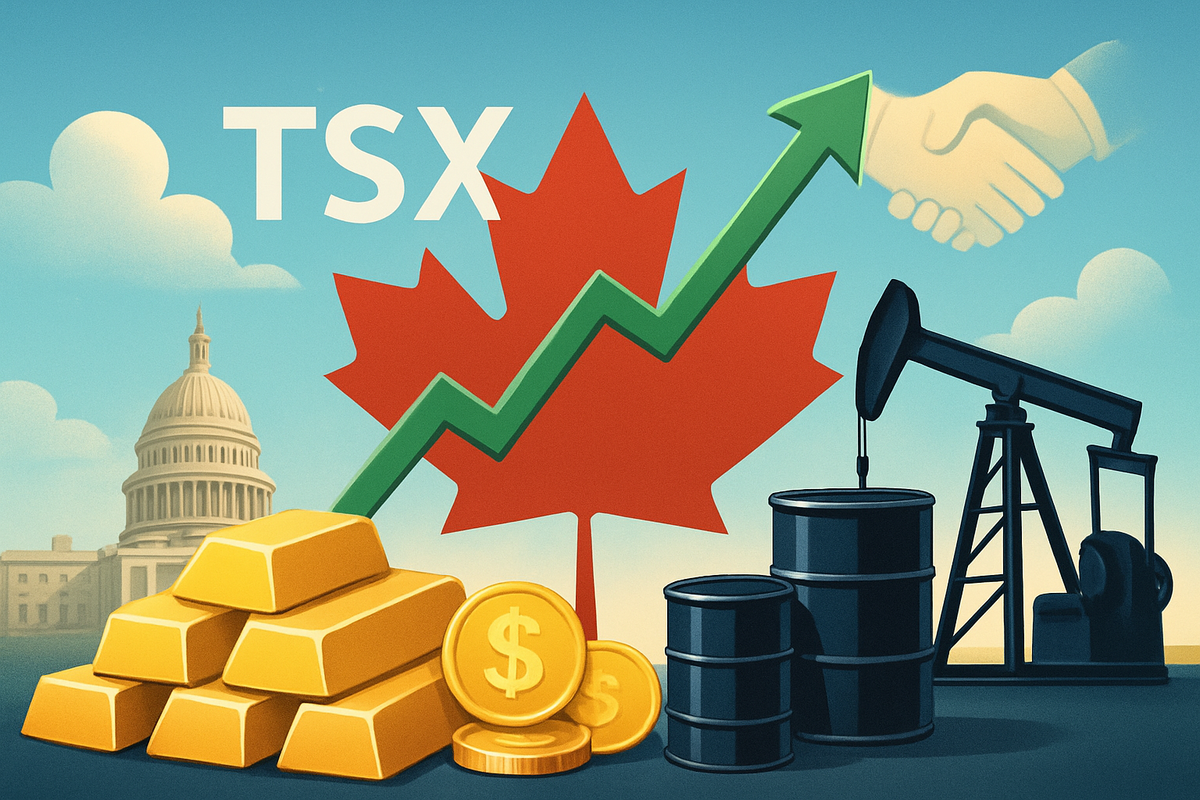
The S&P/TSX Composite Index (TSX: ^OSPTX) has kicked off the week with robust gains, reflecting a surge in investor confidence as fears of a prolonged US government shutdown dissipate and commodity prices experience a significant uplift. The Canadian benchmark index, heavily weighted towards resource sectors, is seeing a strong positive momentum, with futures indicating continued upward trajectory, building on a positive global sentiment. This confluence of reduced political risk south of the border and a broad rally in key commodities is providing a substantial tailwind for Canadian equities, signaling a more stable and potentially prosperous period for the market.
As of Monday, November 10, 2025, the index showed a strong positive trend, continuing its upward movement from the previous week's close of 29,912.19 on November 7. While specific confirmation of the index surpassing the 30,200 mark on this exact date is not definitively available in immediate reports, the overall market sentiment and futures indicate a significant push towards and potentially beyond this level. This strong performance is directly attributable to two pivotal developments: a breakthrough in US budget negotiations and a broad-based rally across the commodity complex.
Market Responds to Easing US Political Tensions and Resource Boom
The primary catalyst for the TSX's strong performance stems from the significant easing of US government shutdown fears. After a protracted 40-day shutdown that commenced on October 1, 2025, US Senators reached a bipartisan agreement on Sunday, November 9, to end the impasse. The Senate successfully advanced H.R. 5371, a short-term funding bill, with broad bipartisan support, aiming to fund the government through January 30, 2026. President Donald Trump has indicated his support for the measure, with his signature anticipated by November 12, 2025, officially bringing an end to the fiscal uncertainty. This resolution has injected a much-needed dose of stability into global markets, reducing economic uncertainty that had been weighing on investor sentiment.
Simultaneously, commodity markets have experienced a notable uplift, providing a direct boost to the Canadian economy and its stock market. On November 10, 2025, gold prices surged, crossing the symbolic $4,000 per ounce threshold, with spot gold increasing by 1.9% to $4,077.00 an ounce and gold futures (COMEX: GC00) also gaining 1.9% to $4,085.65/oz. This rally is attributed to a combination of geopolitical uncertainties driving demand for safe-haven assets and continued central bank purchases. Oil prices also rose, buoyed by optimism that the conclusion of the US government shutdown would stimulate demand in the world's largest oil consumer. Brent crude futures (ICE: BZ00) gained 0.2% to $63.78 a barrel, while US West Texas Intermediate crude futures (NYMEX: CL00) increased by 0.2% to $59.89 a barrel. Furthermore, natural gas prices on the New York Stock Exchange climbed over 4%. The weakening of the US dollar in early November 2025 has further contributed to the strength of commodities, making dollar-denominated assets more attractive to international buyers.
The immediate market reaction has been overwhelmingly positive. Futures for Canada's main stock exchange were notably higher on Monday, November 10, continuing a positive global sentiment that saw Asian and European markets also register gains. The commodity-heavy nature of the S&P/TSX Composite means that rising prices for key resources like gold and oil provide a direct and substantial boost to Canadian equities, particularly within the materials and energy sectors. This combination of reduced political risk from the US and strong commodity performance has set a constructive tone for the TSX at the start of the week, with futures indicating continued upward momentum.
Companies Poised to Win and Lose in the Current Climate
The current market dynamics, characterized by easing US political tensions and a robust commodity rally, present a clear dichotomy of potential winners and losers among public companies, particularly those listed on the TSX. Companies heavily reliant on stable economic conditions and those within the energy and materials sectors are set to benefit significantly.
Potential Winners:
- Energy Companies: Canadian oil and gas producers will likely see increased profitability due to rising crude prices. Major players such as Suncor Energy (TSX: SU), Canadian Natural Resources (TSX: CNQ), and Cenovus Energy (TSX: CVE) are well-positioned to capitalize on higher oil and natural gas prices. The end of the US shutdown also reduces demand uncertainty from the world's largest consumer, providing a more stable outlook for future sales volumes and investment.
- Mining Companies: With gold prices soaring past $4,000 an ounce and other precious metals also performing strongly, gold miners will experience a significant boost to their revenues and margins. Companies like Barrick Gold (TSX: ABX), Agnico Eagle Mines (TSX: AEM), and Kinross Gold (TSX: K) are direct beneficiaries. Base metal miners could also see gains as industrial demand picks up with global economic stability.
- Financial Institutions: A more stable economic outlook in the US and Canada, coupled with rising commodity prices, generally leads to increased business activity and lending. Major Canadian banks such as Royal Bank of Canada (TSX: RY), TD Bank Group (TSX: TD), and Bank of Montreal (TSX: BMO) could see improved loan growth, lower provisions for credit losses, and stronger capital markets activity.
- Industrial and Manufacturing: Companies in the industrial sector that export to the US or benefit from increased capital expenditure in resource industries could also see an uptick. Easing trade uncertainties and a stronger US economy translate to higher demand for Canadian goods and services.
Potential Losers (or those facing headwinds):
- Companies Sensitive to Input Costs: While many benefit, some companies that use commodities as significant inputs (e.g., certain manufacturing or transportation firms) might face increased operational costs, potentially squeezing margins if they cannot pass these costs onto consumers.
- Defensive Stocks (relatively): In a risk-on environment driven by positive news, traditional defensive sectors like utilities or consumer staples might see relatively less investor interest compared to cyclical sectors like energy and materials, which tend to outperform during commodity booms and economic expansions.
- Companies with US Exposure to Government Contracts: While the shutdown is ending, the preceding 40-day period likely impacted companies with significant contracts or dependencies on US government spending, leading to delayed payments or project deferrals. The recovery might be gradual for these specific entities.
Overall, the current environment strongly favors the resource-heavy sectors that dominate the TSX, creating a clear advantage for Canadian-based commodity producers and the financial institutions that support them.
Wider Significance: A Return to Stability and Resource Dominance
The recent developments — the resolution of the US government shutdown and the surge in commodity prices — carry wider significance beyond immediate market reactions, fitting into broader industry trends and potentially reshaping the economic landscape. This event marks a crucial return to a semblance of political and economic stability, particularly impactful given the extended nature of the US government shutdown.
Firstly, the bipartisan agreement in the US Senate underscores a renewed, albeit fragile, commitment to fiscal responsibility and governance. Prolonged government shutdowns create immense uncertainty, impacting everything from consumer confidence to business investment and international trade. The resolution of this 40-day impasse removes a significant drag on both the US and global economies. For Canada, which shares the world's longest undefended border with the US and conducts vast amounts of trade, a stable US economy is paramount. This stability reduces regulatory uncertainty for Canadian businesses operating in or exporting to the US, fostering a more predictable environment for cross-border transactions and investments.
Secondly, the broad-based commodity rally reinforces Canada's position as a global resource powerhouse. Gold's surge past $4,000 an ounce, coupled with rising oil and natural gas prices, highlights a persistent demand for raw materials, driven by a combination of geopolitical factors, inflation concerns, and a weakening US dollar. This trend benefits the Canadian economy disproportionately, as the energy and materials sectors constitute a substantial portion of the S&P/TSX Composite. It also signals a potential shift in investment flows towards hard assets and away from more speculative ventures, especially if inflation remains a concern or global uncertainties persist. This could lead to increased capital expenditure in Canadian resource projects, creating jobs and stimulating regional economies.
Historically, periods of government stability and commodity booms have often coincided with strong performance for the TSX. For instance, during previous periods of high commodity prices, Canadian resource companies have seen significant growth, attracting global investment. Conversely, US government shutdowns, even shorter ones, have typically introduced volatility and dampened investor enthusiasm. The current situation, where both positive factors converge, creates a powerful synergy for the Canadian market. It could also have ripple effects on competitors and partners, as Canadian resource companies gain a competitive edge due to favorable pricing, potentially influencing global supply chains and trade dynamics in commodities.
What Comes Next: Navigating Opportunities and Challenges
Looking ahead, the resolution of the US government shutdown and the sustained strength in commodity prices set the stage for both short-term buoyancy and long-term strategic considerations for the Canadian market and its constituent companies.
In the short-term, the market is likely to maintain its positive momentum. The immediate relief from political uncertainty will encourage risk-on sentiment, potentially leading to further capital inflows into Canadian equities, especially those in the resource sectors. Investors will closely watch the implementation of the short-term funding bill in the US and any subsequent legislative efforts to achieve a more permanent budget solution. Any renewed signs of political gridlock could quickly dampen enthusiasm. For commodity prices, continued geopolitical tensions, central bank policies, and the trajectory of the US dollar will be key determinants of their sustained strength. Companies will likely focus on optimizing production, managing costs, and potentially exploring M&A opportunities within the now more favorable commodity price environment.
For the long-term, the implications are more strategic. The renewed emphasis on resource security and the potential for sustained higher commodity prices could lead to significant strategic pivots. Canadian energy companies might accelerate investments in new projects or expand existing ones, potentially focusing on cleaner production methods to align with evolving environmental standards while capitalizing on demand. Mining companies could explore new deposits or invest in advanced extraction technologies to maximize returns from the current price levels. This sustained demand for commodities could also solidify Canada's role as a reliable global supplier, potentially attracting foreign direct investment into the resource sector. However, companies must also adapt to potential regulatory shifts, especially concerning environmental policies that could impact resource extraction and transportation.
Potential market opportunities include further growth in energy and materials, as well as the financial sector benefiting from increased economic activity. Challenges might emerge from potential oversupply if too many producers rush to expand, or from a sudden downturn in global demand if economic conditions deteriorate elsewhere. Investors should also be mindful of inflation, as rising commodity prices can contribute to inflationary pressures, which might prompt central banks to adjust monetary policy, impacting borrowing costs and overall economic growth. Scenarios range from a continued "goldilocks" environment of moderate growth and stable politics to potential renewed political instability or a sharp reversal in commodity prices, each requiring different strategic responses.
Comprehensive Wrap-Up: A Resilient Market Poised for Growth
The S&P/TSX Composite's strong start to the week, fueled by the easing of US government shutdown fears and a significant boost in commodity prices, underscores the Canadian market's inherent resilience and its deep ties to global economic stability and resource demand. The bipartisan agreement to end the 40-day US government shutdown has removed a major cloud of uncertainty, allowing investors to refocus on fundamental economic drivers rather than political brinkmanship. This return to stability is a critical takeaway, signaling a healthier environment for business and investment.
Concurrently, the robust performance of commodity prices, particularly gold crossing the $4,000 mark and sustained gains in oil and natural gas, highlights the enduring value of Canada's vast natural resources. This commodity tailwind provides a direct and substantial boost to the TSX, which is heavily weighted towards these sectors. It also reinforces the notion that in times of global uncertainty or inflationary pressures, hard assets remain a compelling investment. The market moving forward is likely to be influenced by the ongoing interplay between global economic growth, geopolitical developments, and the supply-demand dynamics of key commodities.
Final thoughts on significance and lasting impact suggest that this period could mark a sustained phase of outperformance for the Canadian market, especially if commodity prices remain elevated and global economic growth continues. For investors, the coming months will require close attention to several key indicators. Firstly, monitoring the political climate in the US for any signs of renewed fiscal disagreements will be crucial. Secondly, keeping an eye on global demand trends for commodities, particularly from major consuming nations, will provide insights into the sustainability of current price levels. Lastly, watching for any shifts in central bank monetary policies, especially regarding interest rates and inflation, will be vital as these can significantly impact market valuations and investment strategies.
This content is intended for informational purposes only and is not financial advice




